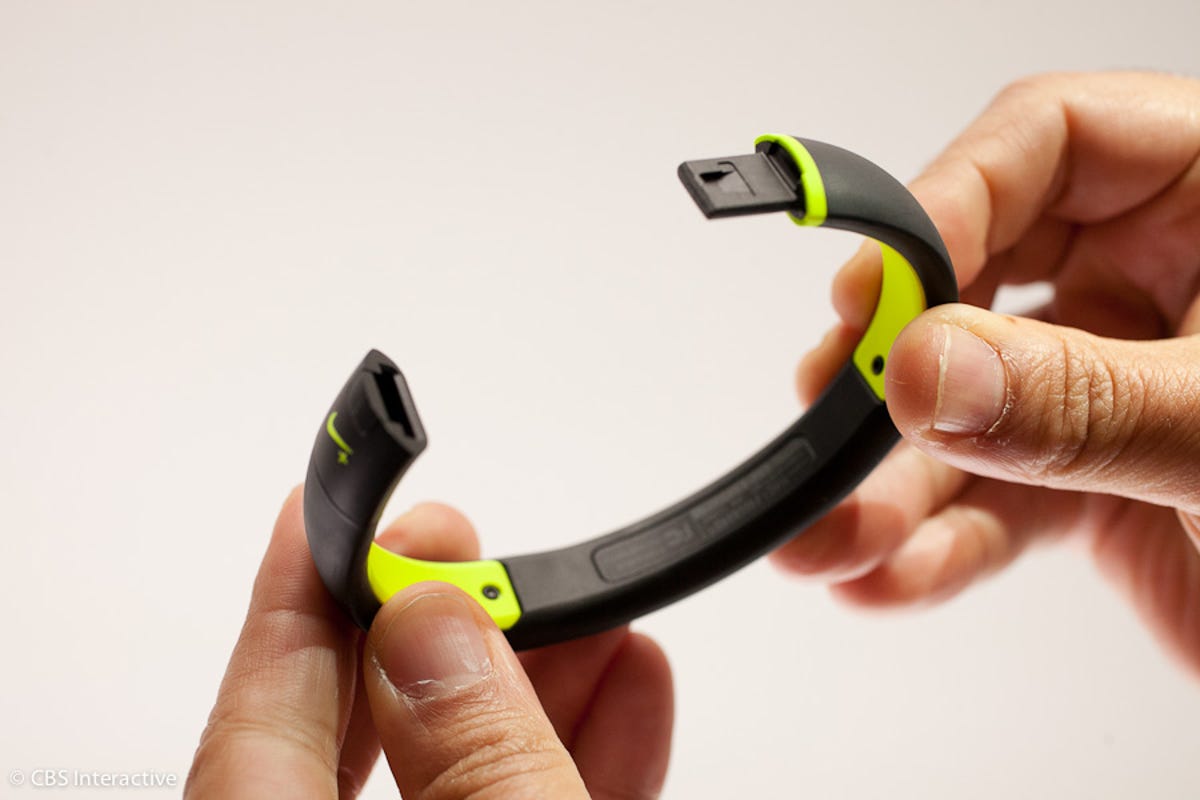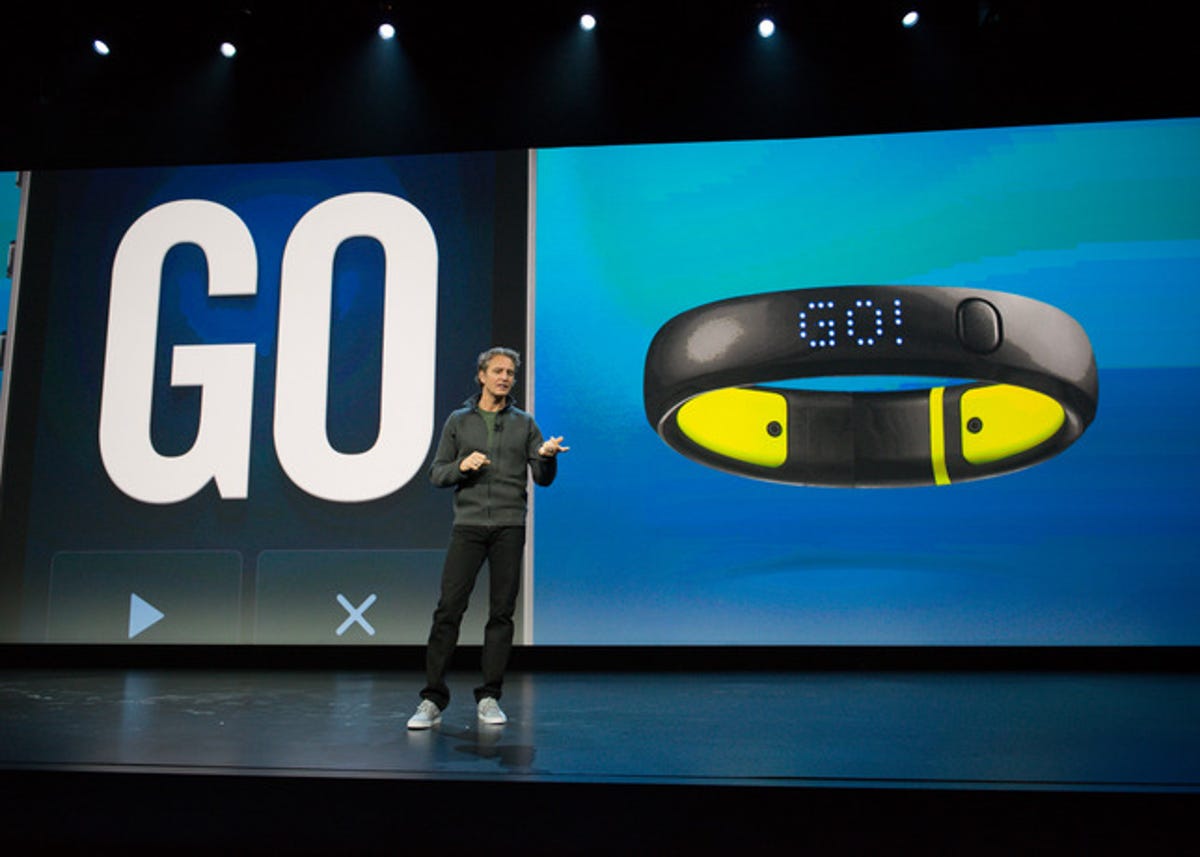
Sarah Tew/CNET
For most of the last decade, Nike has juggled two distinct narratives. On the one hand, it’s still a traditional sportswear corporation that now makes more than $25 billion a year thanks to its in-demand shoes and apparel. On the other, Nike had become an Apple-emulating trailblazer in the uncertain but hopeful market for wearable technology with its FuelBand.
The company has long refused to paint one picture over the other, riding on the perception of being cutting-edge but refusing to downplay the importance of its core business strategy.
Related Stories
- Exclusive: Nike fires majority of FuelBand team, will stop making wearable hardware
- The end of fitness bands? Wearable tech feels ready to move forward
- Nike FuelBand — out of gas already?
But it turns out that Nike’s corporate DNA may not be so divided. The news last week that Nike had fired a majority of the team responsible for development of its FuelBand device — reported first by CNET on April 18 — made clear that a wrist-worn fitness tracker had outgrown its place in Nike’s lineup.
Whether the FuelBand didn’t meet expectations or simply lost its purpose, Nike proved willing to jettison that arm and grow another, a move that hardware-centric wearables companies like Fitbit, Jawbone, Withings, and Garmin can’t afford to make. It’s also evidence that Nike, as a sportswear company first and foremost, sees other avenues outside tech hardware as viable ways to grow its business.
And there may be an Apple angle that plays out down the road.
So with the market for fitness trackers uncertain as watches and phones take on those capabilities — Nike can seemingly do without further development on a $150 device that is still restricted to pairing with the iPhone. After all, selling shoes and building stronger customer relationships can be done with its Nike+ mobile applications for devices both current and upcoming.
“We know that consumer electronics margins tend to be lower than apparel and footwear margins,” said Credit Suisse analyst Christian Buss, who follows Nike. “With the company not having a well established infrastructure or supply chain for consumer electronics, it’s not hugely surprising to me that they would shutter that business.”
To be clear, Nike isn’t closing the doors of its 4-year-old, tech-focused Digital Sport division or making drastic moves like pulling the FuelBand SE off store shelves. The second-generation FuelBand, released in November, will still be sold and will receive application support for “the foreseeable future,” with updated colors as well, Nike said last weel.
However, the company let go as many as 55 engineers and other hardware and manufacturing specialists who oversaw the development of future wearable hardware — including a slimmer FuelBand slated for the fall, a person familiar with the matter told CNET. And with no concrete plans to keep making those wearable gadgets, Nike is making a play to focus on software with Nike+.
“It suggests that they were struggling to make money with those products, and going the software route likely allows them to minimize the capital investment and ongoing investment in these markets,” Buss added.
Nike has never disclosed sales figures of either of its FuelBand models. The NPD Group estimated that in 2013 wearable fitness trackers were a $330 million market, in a competition largely centered around Jawbone, Fitbit and Nike. Fitbit had the lead, capturing 67 percent of sales at brick-and-mortar and large e-commerce retailers, while the FuelBand accounted for 10 percent. That puts Nike’s take at a mere $33 million.
But the decision to downsize its hardware team may not have been as much about the money — the FuelBand was never expected to move the needle on Nike’s bottom line — as it was about what the device brought Nike’s brand, and what role its served going into an Apple-Google showdown, analysts say.
Tech: a means to an end


Nike
While it’s unclear exactly what is going on internally at Nike’s Digital Sport division — the company has yet to publicly acknowledge a winding down of its hardware efforts — one thing is certain. Nike is a sportswear company that sells some technology, not the other way around.
“The tech is a means to an end,” said Sam Poser, a Nike analyst for Stern, Agee & Leach. “It’s not tech for the sake of tech. It is, ‘What can we do to enhance our brand and enhance the customer experience?’
“They [Nike] are not a technology company,” Poser added.
Instead, as at most large companies these days, technology is a necessary presence in the corporate expansion toolkit. It’s worked wondrously for Nike, which has grown its annual sales by around 70 percent since 2006, the same year Mark Parker took over as CEO and the Nike+iPod began selling through Apple’s website. A year earlier, Apple CEO Tim Cook took a seat on Nike’s board, and he’s remained there ever since.
“I think that’s just the result of the world we live in. Tech is being infused into every single one of our products: Our thermostat, our sneakers, our coats,” said Corinna Freedman, an analyst for Wedbush Securities that covers Nike. “I don’t think that they [Nike] wasted time or money. I think they were pretty cutting edge. “
The FuelBand was just one more way to reach athletes in a long line of initiatives from Nike to transform itself into a sport nexus, one aspect of which involves technology. That the device never became a mainstream success is less a sign of an all-out product failure than it is an indication that Nike couldn’t cut it in the murky waters of wearable hardware, and doesn’t really need to if it wants to stay relevant.
“They are so interested and invested in the athlete and the consumer. If tech helps that athlete get to the next level, they’re totally behind it,” said Ben Arnold, a consumer technology analyst for the NPD Group. “We can expect them to come back up as a platform or digital touch point for athletes when they want to use tech to improve their performance. There’s still a big opportunity for them there.”
Nike isn’t admitting defeat. Rather, it made a tough business decision, as any company would. Staying involved in wearables, Arnold says, is an opportunity that can still be leveraged to help Nike’s consumer relationships. The Nike+ app platform is growing, having climbed to 28 million users this month, up from 18 million in August 2013.
“They’re no reason to get caught up in an idea or technology that doesn’t work,” said Poser. “Nike does a lot of really cool stuff, and this [the FuelBand] is one that arguably didn’t work.”
The Apple angle
Why the decision was made now — after serious talks starting months ago, CNET first reported April 10 — and less than half a year after the release of the FuelBand SE is still an open question.
The connection to Apple, which is reportedly working on a wearable called the iWatch, is top of mind for theorists and those who see a Nike partnership as a natural transition for the sportswear company. But all that remains firmly in the realm of speculation — the latest reports point to a
later this year. “It doesn’t seem like an accident to me that these decisions are made as we approach a period with expectations that Apple is supposed to be rolling out a watch,” Buss says.
“Partnering with industry-leading tech companies is nothing new for Nike,” the company said in a statement. Nike noted that it has partnered with Apple since 2006, though the hint-dropping ends with that acknowledgment.
Poser has a different, albeit more conjectured, take. Like an athlete who refuses to play with others who don’t hand over the ball, Nike may not have liked the fact, he said, that it led the charge with the FuelBand only to see small startups begin capturing more of the market just two years later.
“They realized that other people were doing stuff a little bit better than they are,” Poser said. “And they don’t like to play when they’re not the best.”



